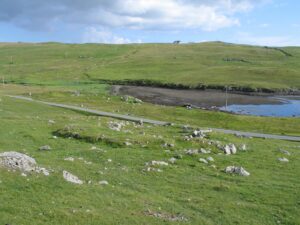
Standing on a windswept hillside in the Northern Isles one cannot help but feel the utmost admiration for our ancestors. We may think that we are technologically more advanced, but as you wander among the ruins of the small farm steadings and their fields that dot the slopes it seems nothing short of miraculous that anyone could produce enough food to support a family here. I’ve been exploring the remains from two very different periods: the Neolithic farms of western Shetland and the Viking farms of Unst. Each evening I have returned to my hotel only too glad of the trappings of modern society: hot water, a warm house, electricity and good, varied food.
The relict agricultural landscapes here are wonderful, and well worth exploring. In many places houses and fields still dot the hillside with little of the overlying debris of more recent centuries. It is an evocative experience to wander among the remains and consider the way in which a place so tranquil once rang to the sound of children, dogs, working people and beasts, together with the smells of peat fire, home cooking and farm debris.
Of course there are many factors at play here. First of all, we have the twin elements of weather and climate. I experienced Shetland during the worst summer storms for a long time (as I write this my flight home was delayed). The times when these landscapes really came alive and the farmsteads were thriving coincided with more clement periods – though not perhaps so very different: a mere change of a degree in temperature or so; a shift in the jet stream; or a few years of better weather, could all make the difference between a good harvest and a bad.
There are also the expectations of the community. Today we all rely on access to washing machines, plenty of food, adequate clothing, and warm homes. But you don’t have to go far back in time to find people for whom life was very different. It always amazes me to consider the photos of rural life a hundred years ago or so that one sees in local museums. There are women bringing peat down from the hillside in great baskets – the loads alone are impressive but what really catches my eye is the fact that in many cases the people depicted are barefoot. We might be worried about hypothermia and a host of other problems but standards were different in the past.
Nevertheless, I don’t want to denigrate the effort and hardship of previous generations. I’m sure that people felt cold, tired, miserable and hungry much of the time. Most of us have forgotten how it is to rely on our own hard work in order to survive. When we need food we go to the supermarket. When we need heat we turn up the gas or electricity. Those who farmed the hillsides of Britain in times past experienced a very basic level of survival. Life could turn on a shoestring. When times were hard, when they could not harvest an adequate crop, when they could not support the animals through a wet summer or a cold winter, then people died. The hillsides that we wander for recreation today may look romantic, but life there was no agricultural idyll in the past.
I’m still left in awe of those who made their homes here in years gone by!
You must be logged in to post a comment.